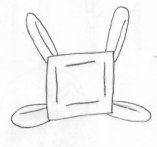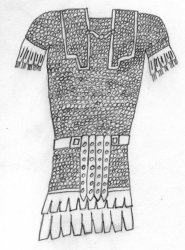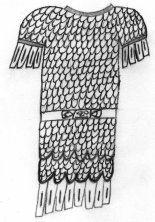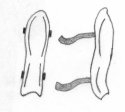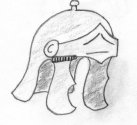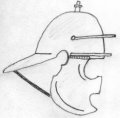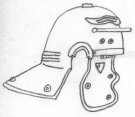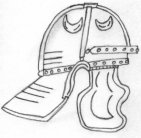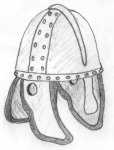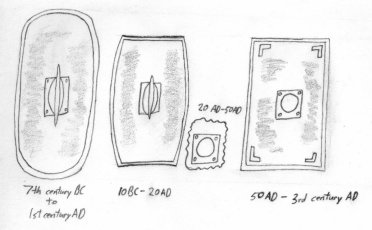The Roman Legions managed to conquer most of the known Western world, allowing the emperor (orimperator) to control one quarter of the people on the planet at the time. This vast amount of territory was controlled by one of the first “modern” armies, who dictum of standardization and high equipment quality made them the best-equipped soldiers of the ancient world. Compared to most other opponents, the Romans were heavily armored, heavily armed, and highly skilled at using their weapons and equipment.
And as with any army, equipment changed over time and evolved to suit the particular tactics employed by Roman army. In some cases it was a matter of cultural preference, while in others it was simply a matter of economics, but mainly policy. You will see the name Marius mentioned in this article, or the phrase Marius’reforms. This refers to the Roman commander Gaius Marius (157-86 BC), who revolutionized the army by allowing any Roman citizen to join, regardless of whether they owned property or not. This volunteer army was far more motivated and provided better defense (or offence as the case may be) for Rome than the old land-owing, class based army of earlier times. But the main thing that Marius did was to standardize equipment, which up until then had been provided by the individual soldier. Now Rome had an army made of men who all used the same swords, had the same shields, and wore equivalent armor.
Armor – Early in Rome’s history its armies fought according to the Greek phalanx style, using Greek-style armor. As the Roman army developed into the more flexible forces of the Republic and Empire, it developed its own styles of armor. Although not shown here, officers sometimes wore a solid metal muscled cuirass, shaped to resemble a sculpted male torso.
Plate
In the early days of the Republic, each individual land-owning citizen supplied his own armor and weapons. At the time chain mail was the best protection available for the Roman citizen soldier, but this was expensive, precluding most soldiers from having it. Instead a simple square brass plate could be used, placed over the sternum (known as pectorale). It was held in place by four straps that went over the soldier’s shoulders and torso. Back and breastplates were common in Italy, used by the Etruscans in the north and the Samnites in the south. Roman pectorale were used during the Second Punic War and were never abolished until Marius’reforms.
Chain Mail
For pure universality, there is no armor used by more cultures than chain mail, which appeared in the 5th century BC from the forges of Celtic blacksmiths. Its interlocking iron rings made it strong and was capable of stopping a sword slash or an arrow. The Romans probably obtained chain mail from the Gauls who invaded northern Italy in 387 BC. Rich early Republican-era soldiers would have worn a heavy chain mail hauberk, known as a lorica hamata, and it was issued as the standard armor of legionnaires after Marius’ reforms. By the mid 1st century AD the lorica segmentata had become the standard issue cuirass of the Roman legions, but it could never replace the hamata, which was used until the end of the Roman Empire in one form or another. While chain mail may not have been as common during the 1st and 2nd centuries AD in the legions, it was always used to some degree by legionnaires and was standard issue to auxiliaries, centurions, and cavalry.
Scale
Scale armor was the rarest form of armor worn by Roman soldiers, made up of small metal plates sewn to a leather or fabric garment. While more commonly associated with the Sarmations, scale hauberks, or lorica squamata, were worn by centurions and standard bearers, as well as cavalry.
Strip
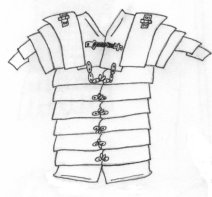
When one thinks of Romans the image of the typical 1st and 2nd century AD legionnaire comes to mind, with an Imperial Gallic helmet on his head, a rectangular scutum, two pilum, and a lorica segmentata. We don’t exactly know what the Romans called the heavy strip armor cuirass, segmentata being a modern word made up to place after lorica (armor). What we do know is that this form of armor was extremely popular, giving incredible protection and a huge range of motion. Composed of strips of armor covering the shoulders and torso bound together by brass fittings, the segmentata allowed for maximum movement and adjustment for fit. One interesting side note is that a scarf had to be worn to prevent the strips from chaffing the neck. Only legionnaires wore the segmentata, so only they needed scarves, but they quickly became popular in the auxiliaries, who wore it simply as a fashion statement. The lorica segmentata began to enter service around 40 AD, being used until the early 4th century AD, when it was replaced by chain mail. This was probably due to economic reasons, as the army had grown by a huge number since the 1st century AD.
Greaves
Greaves were worn in the pre-Marian era by anyone who could afford them, either a pair or one, usually placed on the foremost leg. After Marius only officers wore greaves, the most famous users being centurions. In special instances greaves were issued to the rank and file, most famously in the Dacian War, where they were used to counter the vicious falx wielded by the Dacian infantry.
Helmets –The first five following helmets are what can be described as the classic Roman helmets. The Ridge style helmet was used by Romans in the late Empire, but is not technically “Roman”, being based on Persian and Sarmation helmets. Used early on was a uniquely Italian helmet known as the Etrusco-Corinthian type, which was designed to look like a Corinthian helmet when it was pushed up off the face of a resting hoplite. Crests were worn by troops in battle until the early 1st century AD, after which they were only worn while on parade. Centurions wore a transverse crest in battle, made of feathers or horsehair.
Attic
By the 5th and 4th centuries BC Greek colonies had been established in the south of Italy for quite some time, bringing with them hoplite combat equipment. One of the helmets brought over by the Greeks was the Attic style, a relatively minor style in Greece but hugely popular in Italy. Sometimes characterized by an inverted “v” on the forehead of the helmet, the Attic was used by the Romans from the 4th century BC until the 1st century AD. In early Republican times average soldiers wore Attic helmets, but when the Montefortino style was made standard issue by Marius, it became an officer’s helmet until its disappearance.
Montefortino
Based on Celtic helmets, the Montefortino was the first semblance of the true “Roman” helmet to appear, beginning its tenure with the Roman army sometime in the late 4th century BC. It was essentially a Celtic pot-like bronze helmet bowl combined with Italian cheek-guards, along with a plume at the peak. It was relatively cheap, provided good protection, and was very popular. When Marius reformed the army, it was made the standard issue helmet of the legions until it was replaced by the Coolus style around 50 BC, but remained in use until the early 1st century AD.
Coolus
The Coolus style entered service with the Roman army some time around 50 BC, replacing the Montefortino. Made of brass, the Coolus was based on Celtic helmets as the Montefortino was, but brought new features like a bill at eyebrow level to deflect sword cuts and a longer neck guard. This was also the last legionary helmet to carry plumes and crests into battle and was replaced by the Imperial Gallic type in the first half of the 1st century AD. While the Coolus lingered on with the odd legionnaire until the late 1st century AD, it did go on to be the standard issue auxiliary helmet.
Imperial Gallic
The lorica segmentata is the classic Roman armor and the Imperial Gallic is the classic Roman helmet. Manufactured in Gaul for the Roman army, beginning sometime in the late 1st century BC, the Gallic improved upon the Coolus, adding an even larger neck guard, ear guards, and the characteristic “eyebrow” designs on the forehead. It was also one of the fancier helmets of the Roman army, standard issue when the Empire was at the height of its power and the Gallic was indeed the highest quality helmet that the legions ever received. It remained in use until the early 2nd century AD, when the Imperial Italic helmet became popular.
Imperial Italic
While very similar to the Imperial Gallic, the Italic features several characteristics that separate it from the former, the first being the reinforcing cross-braces meeting at the top of the helmet. In addition the larger cheek pieces allow for a more enclosed helmet providing great protection and could often be very ornate. The Italic was initially an inferior Italian made version of the Gallic type, but soon developed into its own style. It entered service sometime in the 1st century AD and was used until the mid-3rd century AD.
Ridge
By the 4th century AD the Roman army had changed radically from the early Empire: the weapons had changed from pilum and gladius to lancea and spatha, armor from segmentata to hamata, and helmets from Gallic to Ridge style. This attractive helmet seems to be based on Roman cavalry helmets of the 3rd century AD, which had drawn their influence from the Sassanian Persians and the Sarmations. The helmet offers protection to most of the head due to its large cheek guards, nasal bar, and deep neck guard. In some cases the ears protruded from the ear holes but were not protected by ear guards as seen on earlier helmets. Anyone familiar with the Saxons and the Sutton Hoo helmet will notice quite a few similarities with the Ridge helmet, which remained in use by various peoples after the fall of the Empire.
Swords – The sword was the main weapon of the Roman soldier, since his pole arms were thrown as he approached the enemy. As a result the Roman army was made up of expert swordsmen who easily defeated opponents who were unused to the close-combat style practiced by legionnaires (especially enemies fighting in a phalanx). Coupled with a large shield, the Roman soldier was perfectly equipped to use his blade to maximum effectiveness.
Xiphos
As stated before, the Greeks brought hoplite combat to Italy along with their colonists. The early Romans and many Italian nations fought using the typical hoplite straight sword (known as a xiphos), which measured roughly 30 inches in length. It would have remained in use until the First Punic War, when the Romans were introduced to the Iberian gladius, which quickly replaced the Greek weapon.
Gladius
One of the most famous swords in the world is the gladius, the short Roman double-edged stabbing sword. Initially the design came from the Iberian Celts, many of whom fought in Hannibal’s army during the Second Punic War, bringing the roughly 27 inch gladius hispanicus with them. The Romans were quite impressed with it and encountered it later when Scipio Africanus invaded Spain. Shortly afterwards Roman soldiers began carrying the gladius in combat, reeking havoc with it through Macedonia soon after the end of the war with Carthage. As with so many pieces of Roman equipment, Marius made it the standard issue blade of the army and it remained so until the 4th century AD when the more Germanized army switched to the spatha. Despite it’s relatively simple, if not quaint appearance, the gladius was fully capable of shearing of limbs and heads at a single blow. It was normally used in a thrusting motion; the soldier would jab his arm straight out aiming for the heart of his opponent, twisting it just before impact to increase the force. There were two main forms of the gladius, the Mainz type (1st century BC), which had a wasp-waisted blade and the Pompeii type (1st century AD on) featuring straight edges.
Spatha

Derived from Celtic long swords, the spatha was used mainly by the Romans mainly as a cavalry sword beginning some time in the late Republic. Visually it looks similar to the gladius, except that it is longer (roughly 3 feet) and not as broad, denoting its use as a slashing weapon. While it was reserved for cavalry in the early Empire, by the 4th century AD the Roman army was composed of mostly Germanic soldiers who were used to wielding the longer sword and the spatha became the standard issue sword of the army. It was used until the end of the Empire by both the cavalry and infantry.
Other
Pugio
All Roman soldiers between the 2nd century BC and the 2nd century AD were issued this dagger, which was worn at all times, even off duty. Off duty it was used as a utility knife, but in battle was the last ditch weapon of a legionnaire, but probably used mainly for dispatching wounded opponents. While the blade could vary, the handle remained constant through the period the weapon was used. The roughly 14-inch pugio was worn on its own belt, which was separate from the gladius baldric.
Pilum
Originating in the early 5th century BC and used until the end of the Empire, the pilum was the standard Roman pole arm as dictated by Marius. Each legionnaire carried a pair of pila, earlier on one heavy and one light, but by the 1st century AD a pair of standard roughly 7-foot pila were carried. As the legion went into battle, the legionnaires would hurl their pilum at their opponents at a range of approximately 60 feet, then draw their gladii and either wait for their opponents to come to them or charge into their midst before the enemy had time to reorganize from the sudden onslaught of missiles. The pilum featured a long metal rod which served several purposes: first it allowed the pilum to plunge through an opponent’s shield and continue on into the enemy beyond, it also pinned enemy shields together, forcing them to throw them away (thereby making themselves more prone to the gladius), and finally the rod would bend upon hitting the ground, rendering the weapon worthless and ensuring that the enemy could not simply pick it up and throw it back at the Romans. By the 2nd century AD a bronze weight had been added to the javelin, increasing range and armor-piercing capability.
Hasta
The hasta was a basic thrusting spear from the early Republic, used by troops known as triarri. Similar to the hoplite spear, the hasta measured roughly 8 feet long. It was eliminated from the Roman army when the pilumwas made the standard pole arm of the legions.
Lancea
Faced with larger numbers of horseman as opponents, the Roman army abandoned the pilum as the standard pole arm and turned to the lancea, a spear suitable for thrusting or throwing. The logic was that an infantryman stood a much better chance against a Sassanian cataphract, a Gothic horseman, or a Hun when he was able to keep him at long range with a 7-foot spear, instead of having to duck in for a kill with a spatha. As a result late Roman soldiers used the lancea as their main weapon until the end of the Empire.
Verutum
Although used mainly in the late Empire, the verutum had a long history with the Romans, having been used by the velites (light skirmishing troops) of the early Republic. It was a short (4 foot) javelin sometimes equipped with a strap attached to it, which aided in throwing it. After the introduction of the pilum, the verutum was sidelined, but was readopted in the late Empire.
Scutum
As with helmets, the Roman shield, or scutum, changed over time evolving as the needs of the soldiers changed. Originally Romans carried an oval shaped shield with an oblong metal boss and curved so it gave lateral protection to the user. The shield was made of plywood (various layers of wood glued together), covered with leather or another material (linen, felt, canvas), and rimmed with iron. The next innovation involved cutting off the top and bottom of the scutum to lower the weight, which happened roughly around 10 BC and was known as the Augustan style. Next the oblong boss was replaced by a round example around 20 AD. The curve-sided shield was replaced by the more recognizable rectangular scutum sometime around 50 AD. While rimmed with iron as all the previous models had been, the rectangular shields also had L-shaped reinforcing strips in the corners. In the mid-2nd century AD the army returned to the oval, which had replaced the rectangular type in the 3rd century BC. The slightly more circular-shaped oval shield was used until the end of the Empire. In battle a legionnaire would use his shield offensively as well as defensively, pushing forward against his opponent with it and punching with the boss.
